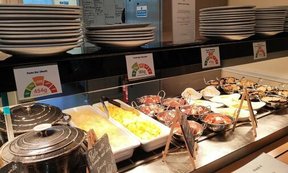The research study deals with a field experiment testing the impact of a CO₂ label on meals in several university cafeterias at the University of Cambridge. The label, which was co-developed by British designers, was similar to a traffic light label that easily indicated the CO₂ footprint of a menu: particularly climate-friendly menus were marked in green, while menus that were particularly harmful to the climate were marked in red. In total, more than 80,000 individual consumer decisions were observed.
The results show that labels significantly reduce the consumption of meat and fish dishes, which on average have a very high footprint, but do so only in a very modest manner (by about 2%). Over the duration of the experiment, more than 2 tons of CO₂ were saved in the participating cafeterias. The study therefore suggests that a CO₂ label, which provides information about the environmental impact of food served in restaurants or cafeterias, can steer consumer choices in an environmentally friendly direction and thus may be an important component of a sustainable food policy.
The study entitled 'Do carbon footprint labels promote climatarian diets? Evidence from a large-scale field experiment' has been accepted for publication by the Journal of Environmental Economics and Management. Additional coverage can be found on the homepage of Die Presse and an interview on the article was published in Die Furche.

